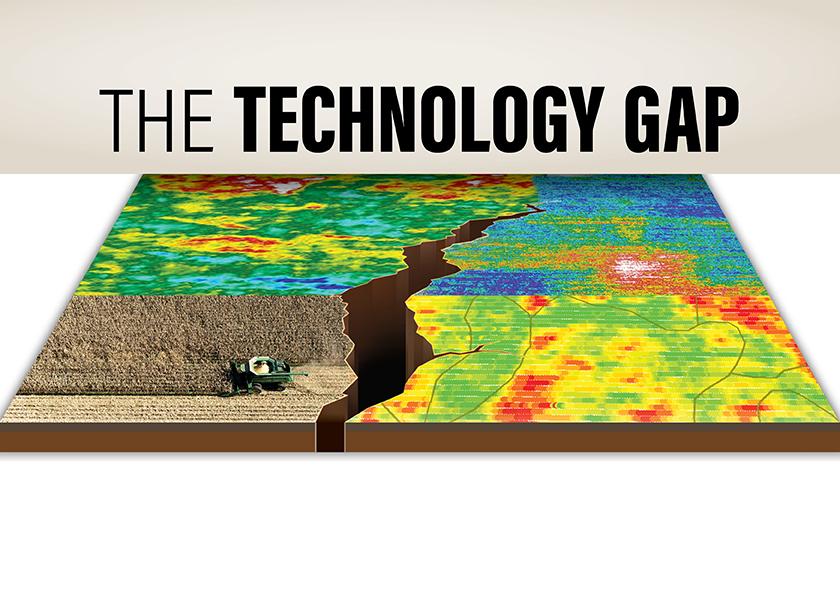The Ag Technology Gap: When Promises Fall Short Of Results

“Agriculture doesn’t have an innovation problem,” says Mississippi producer Chad Swindoll. “It has an implementation problem.”
Digital information is a realm of genuine opportunity for agriculture, but the shine of a new digital product often dulls in the rows. Boiled down, many growers believe there is a gap between what is offered in the ag data market and what is needed.
The basic data framework is a company builds software and sells the product on a subscription, fee or standard one-time transaction. But for the grower at the end of the chain, the promises can be paralleled by pitfalls.
“When the focus is on a tool, rather than a result, something is out of kilter,” Swindoll says.
WHEN THE DEAL IS DONE
In Tallahatchie County, Miss., Swindoll grows corn and cotton and owns consulting firm J19 Agriculture. Prior to J19, he worked for several years as a field representative for a precision ag tech company and encountered a consistent request from growers: “Can you help me with my data?”
“I turned down requests all the time,” he says. “They had been told or heard that data is useful, but just didn’t know how or where to start.”
Most ag data revenue models are built around products, and not customer success, Swindoll contends.
“It’s like being in a store,” he says. “You go in and buy a product and you pay the company; the deal is done. The problem for a farmer is not about a lack of tools. Instead, the problem is finding someone with a financial incentive to make the tools work.”
In Bolivar County, Miss., Adron Belk grows corn, rice and soybeans. He gleans university data for management help but is resolute in obtaining data directly off his own ground.
For the past five years, Belk has placed 50% to 75% of his land in strip trials. He tests variety, fertilizer placement, fungicide, irrigation and more.
Belk generally runs three major company platforms, and the interchange can be a major tangle.
“Crossing boundaries is not simple,” he says. “All three companies help me with their products, but the interchange is a different matter. At end of day, I want to farm — not wrestle data.”
DEPTHS OF THE GAR HOLE
Agribusiness and farmers are still discovering what data information is worth, Swindoll explains.
There remains a segment of growers who adhere strictly to farm history to interpret what happens in the rows. For example, Farmer Joe looks across a particular field and tabulates the oral traditions of his forefathers, along with his own field experiences, and accounts for all the good and bad spots. Therefore, the case is closed.
Summed from a slightly different angle: Knowledge of the gar-hole locations sustained his family in the past: therefore, the knowledge is ample for his family in the future. Swindoll dents the armor of the I-know-my-own-ground attitude with legitimate questions.
“There is a world of difference between knowing something is bad and knowing precisely how bad it is,” he says. “Question: What is the exact impact of a gar hole? You can’t force against a we’ve-always-done-it-this-way mentality, but you can ask questions that make people think critically.”
DATA = KNOWLEDGE
Trey Brower grows corn, cotton, soybeans and sweet potatoes in Calhoun County, Miss. He is new to ag data analysis, and 2020 was his first year to “get serious.” The biggest data issues for Brower are implementation and compatibility.
“That’s a big gap to me,” Brower says. “I know my good areas and bad areas of each field, but I want to know the why of what I can’t see. I want to nail down exactly why and develop mapping data. Data is knowledge.”
One of the best data actions a farmer can implement is the organization of field records. One of Swindoll’s go-to questions to ask a grower: “Can you tell me what you planted on this field on this day — population and variety?” He often receives muddied answers.
“It’s 2022, and many farmers don’t know the real numbers,” he says. “The information is being held captive on a computer in a tractor sitting on a farm lot somewhere. Nobody wants to say it, but we’ve got producers who don’t know how to effectively use yield monitors because they haven’t been taught or taken the time to learn.”
HOW TO BUILD A WATCH
Despite the data hitches, the road ahead is wide open, paved with many high-performing products, Swindoll says.
“Things will continue to get cheaper and improvements in cellular capability will take data from field to office at even more incredible speeds,” he says.
No matter the future of ag data, a human touch will always be needed to weave the patchwork together.
“People don’t want to get a long chain of data; they want to know three things they can act on right now and why,” Swindoll adds. “It’s like the old saying: ‘Don’t tell me how to build a watch, just tell me what time it is.’”
Swindoll frequently receives two blunt questions from farmers. The first: “I use brand X software. It is good?” The second: “What should I buy?”
His answer requires a peek over the near horizon: “I tell guys, ‘If it works for you, then keep using it, but you must have an exit strategy.’ Companies continue to get bought and sold at a fast pace, but if you ask almost anybody in farming, ‘Will ag data will be more or less important in 10 years?’ They’ll answer: more. Therefore, we have to be more methodical on who we partner with to handle data.”







